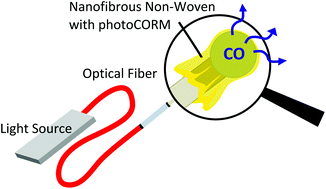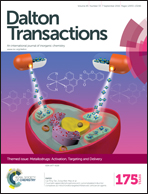Remote-controlled delivery of CO via photoactive CO-releasing materials on a fiber optical device†
Abstract
Although carbon monoxide (CO) delivery materials (CORMAs) have been generated, remote-controlled delivery with light-activated CORMAs at a local site has not been achieved. In this work, a fiber optic-based CO delivery system is described in which the photoactive and water insoluble CO releasing molecule (CORM) manganese(I) tricarbonyl [(OC)3Mn(μ3-SR)]4 (R = nPr, 1) has been non-covalently embedded into poly(L-lactide-co-D/L-lactide) and poly(methyl methacrylate) non-woven fabrics via the electrospinning technique. SEM images of the hybrid materials show a porous fiber morphology for both polymer supports. The polylactide non-woven fabric was attached to a fiber optical device. In combination with a laser irradiation source, remote-controlled and light-triggered CO release at 405 nm excitation wavelength was achieved. The device enabled a high flexibility of the spatially and timely defined application of CO with the biocompatible hybrid fabric in aqueous media. The rates of liberated CO were adjusted with the light intensity of the laser. CO release was confirmed via ATR-IR spectroscopy, a portable electrochemical CO sensor and a heterogeneous myoglobin assay.

- This article is part of the themed collection: Metallodrugs: Activation, Targeting, and Delivery

 Please wait while we load your content...
Please wait while we load your content...